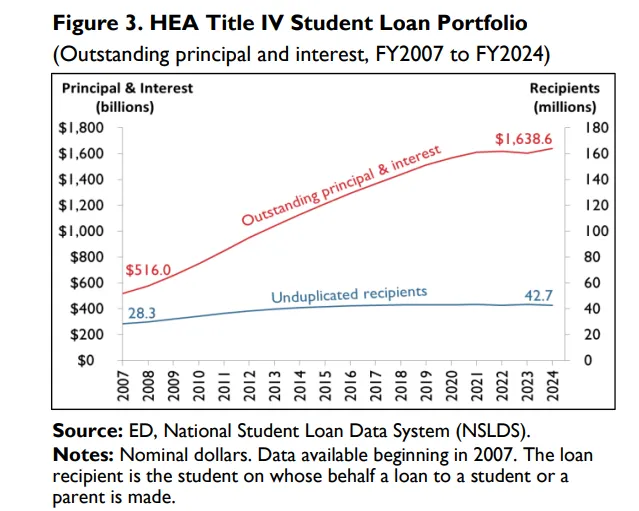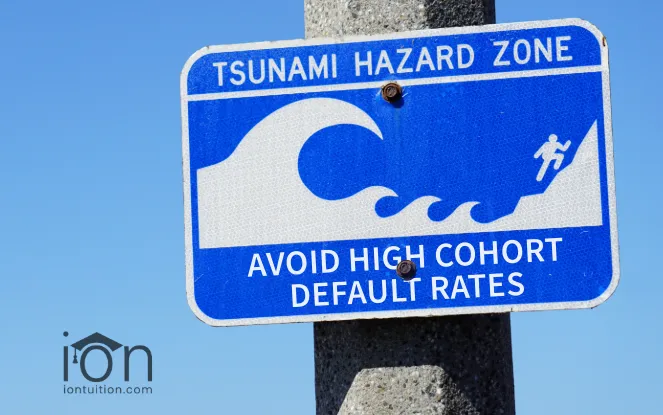The warnings have been sounded. As we highlighted in previous blogs, the end of the three-year pandemic era payment pause, ongoing borrower confusion, federal servicer limitations, and economic pressures have created a perfect storm for a student loan default crisis.
Now, the storm is upon us. The number of student loan borrowers between 30 and 180 days delinquent currently stands 3x higher than before the COVID payment pause began.
January 2025 marked the first time delinquent borrowers faced negative credit reporting in four years, and the clock is ticking toward widespread defaults later this year.
Are colleges prepared for the tsunami-sized wave of defaults about to hit their Cohort Default Rates (CDRs)?
Over the past 17 years, the federal portfolio of outstanding Title IV loans increased from $516 billion in loans made on
behalf of 28.3 million students to $1.6 trillion in loans made on behalf of 42.7 million students.

For the past few years, colleges have enjoyed artificially suppressed CDRs due to the payment pause and subsequent on-ramp period. This period of reprieve masked the growing financial struggles of many borrowers.
Now, with the on-ramp over and the consequences of delinquency kicking in, the true picture of borrower distress is emerging.
The 2023 and 2024 cohorts face unprecedented challenges, and the resulting spike in defaults will significantly affect institutions.
Why This Year is Different
Several factors make this year particularly critical:
- The End of Forbearance: The years of paused payments have created a generation of borrowers accustomed to not paying. Re-integrating loan payments into already stretched budgets is proving incredibly difficult, leading to widespread delinquency.
- Borrower Confusion: The ever-changing landscape of loan forgiveness programs, IDR plans (SAVE, ICR, PAYE), and legal challenges have left borrowers bewildered and uncertain about their options. This confusion often leads to inaction, which quickly translates into delinquency and default.
- Economic Pressures: Inflation continues to erode purchasing power, making it even harder for borrowers to afford their monthly payments. Many are prioritizing essential expenses over student loan repayment.
- The Return of Consequences: The grace period is over. Delinquencies are now being reported to credit bureaus, impacting borrowers’ credit scores and future financial opportunities. This is a stark reminder of the real-world consequences of missed payments, and it’s driving many towards default.
The Looming CDR Crisis for Colleges
High CDRs can have serious implications for colleges, including:
- Loss of Federal Funding: Institutions with consistently high CDRs risk losing eligibility for federal student aid programs, a critical source of revenue.
- Reputational Damage: High default rates can tarnish a college’s reputation, making it harder to attract prospective students.
- Increased Scrutiny: Colleges with high CDRs may face increased scrutiny from accrediting agencies and regulators.
What Can Colleges Do?
The time for proactive intervention was last year. Colleges must implement comprehensive default aversion strategies to support their borrowers and protect their institutional standing. Here are some key steps:
- Proactive Outreach: Reach out to borrowers before they become delinquent. Provide clear and personalized guidance on repayment options, including IDR plans.
- Simplified Resources: Create easy-to-understand resources that explain the complexities of student loan repayment. Cut through the confusion and provide clear, actionable information.
- Personalized Support: Offer one-on-one counseling with student loan experts who can help borrowers navigate their situations and choose the best repayment plan.
- Early Intervention: Identify at-risk borrowers early and provide targeted support to prevent them from falling behind.
- Leverage Technology: Utilize technology platforms that streamline the repayment process, such as online IDR applications and personalized financial planning tools.
Don’t wait until your borrowers default. Contact IonTuition today to learn how we can help you protect your institution’s future. The tsunami is coming – we’re here to help.

